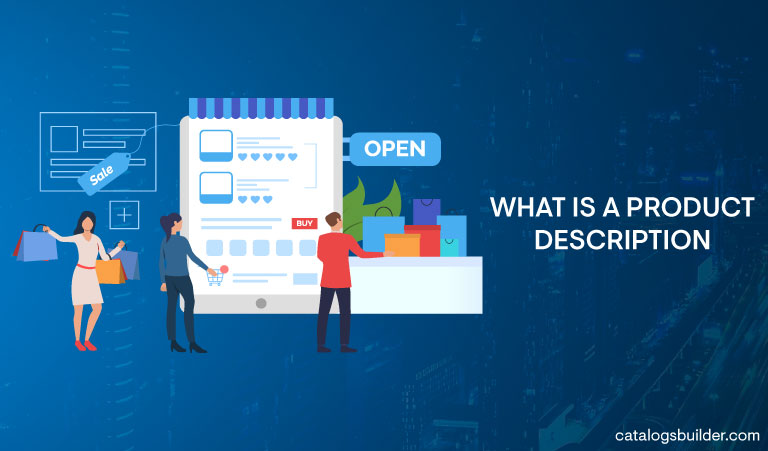It is a challenge to create eCommerce product descriptions that are accurate and concise. The goal is to give shoppers all the information they need, while also taking economics into account: however human attention is a limited supply.
What can you do to ensure that your eCommerce site provides customers with the right amount of information that they need? Find out by reading on.
What is a Product Description?
On each product page, a product description tells a shopper what a product is all about and why they should buy it. Product descriptions are intended to explain the features your customers may find interesting, along with other factors they might find interesting about it.
Sales tool for eCommerce
By targeting your ideal customers directly with your product descriptions, you can create a valuable sales tool. Consider how you want to appear. To establish credibility and trust, make sure your copies are error-free. In order to connect with potential customers, the copy should reflect the tone and personality of your brand and products.
Describe the benefits and features of the product
There are two main aspects of a good product description: its features and its benefits. Your product page copy relies heavily on these. Features are qualities or functions of products. A feature such as "this mobile case is waterproof" is described, for example.
The benefit of a product is the value it gives the customer. An advantage of the case's waterproof properties is that "you won't have to worry about the rain"; this is its benefit.
Make sure your product copy is as specific and clear as possible. By letting shoppers see the features and benefits of a product, let them come to that conclusion that it's high-quality; you rather don’t just say it.
To learn more about it in detail take a look at "What is Product or Service Description?" now!
Tips for Writing Product Description Format
You can't just describe your products - they must be sold. You can increase sales by writing product descriptions that follow these 5 tips.
1. Know your audience
Understanding your audience is the key to appealing to them. Instead of trying to please everyone, focus on your ideal customer's buyer persona which we actually do at CatalogsBuilder.
What kind of customer do you want? How do they feel about a product? What are their priorities? Doesn't it make sense?
Among Berkshire Natural's customers are health-conscious individuals who also prefer fast, tasty snacks. A product description connects them with their customers: Imagine the chocolate bars you ate as a child, but with a grownup twist. With only 110 calories, it's now healthy, made with coconut and chia seeds.
Clearly, this is the type of customer they are looking for. A casual tone fits with the brand's overall image of hipness, friendliness, and social responsibility. Product descriptions should reflect the "personality" of your company.
This trick can be helpful: Consider yourself a sales associate at your brick-and-mortar store. When dealing with customers, what tone of voice would you use? How would you describe the language? Your product descriptions should be written in that same tone and language.
2. Paint a picture
Using descriptive and vivid language is the best way to present a product's benefits.
While a picture can convey a thousand words, vivid, descriptive language can also create imagery in product descriptions. According to research, 88% of shoppers value detailed product content highly. Technical specifications aren't necessary. Instead, describe the product's experience, not just the product itself.
This can be accomplished by making a list of all the important details or features of a product. Determine what each item offers the customer. A key feature should provide a benefit, whether it is a function, an aesthetic, or a comfort factor. To make your customers understand these benefits, use descriptive language. Give them an idea of how your product will feel to them.
A coconut chia bar from Berkshire Natural, for example, is described as follows:
A coconut addition unlocks the fruity, roasted taste of chia bars. Replace regular chocolate bars with fruity quinoa bars for quick energy and a delicious texture. A 15-minute time is all it takes to boost energy from our single-serve chia coconut bar.
Through this vivid description, customers not only learn the features of the product (low calorie, quick energy, and versatile) but also how it will feel once they have experienced these features. If you use the description that completely defies the fruity taste of chia coconut in recipes, you can create a quick and tasty meal.
The image related to your product should be similarly vivid.
3. Format strategically
Screen reading has changed how people consume written content in recent years. Considering that a potential customer only reads 16% of the content on any given web page, you need to maximize the time you have with them.
Skimming is the new normal, according to literacy experts. Therefore, compelling product descriptions must be easy to understand.
The following formatting tricks will increase conversion rates by grabbing and keeping shoppers' attention:
- Use bullet points to create scannable lists.
- Make sure your product photos are high-quality and eye-catching.
- The titles, headings, and subheadings of your products should include power words that break up long blocks of text.
- Descriptions of products should be short and to the point.
- For easier reading, increase the font size.
- Make sure there is plenty of white space.
- A cut or separate tab should be used to place lengthy technical details.
4. Leverage social proof
Online reviews influence shoppers' buying decisions, while 72% won't make a purchase unless they read a positive review. 55% of shoppers' buying decisions are influenced by online reviews: Social proof makes your business and products more credible.
It can make the difference between potential customers placing an order or abandoning their cart if they see reviews from other customers. Positive reviews are the only thing that makes 72% of buyers act.
It's great to get customer reviews as social proof, but they're not the only way to build social commerce. Customers are often asked to share photos of themselves wearing the clothes in their daily lives by clothing retailers, for example. Customers can envision themselves wearing or using the product every day as a result of this.
A retailer may also mention a certain item's price and purchase data, such as “Over 1,500 sold!” or “Viewed by 98 shoppers today.” It's also possible that the item will sell out soon due to the high level of interest.
5. Have high-quality product images
56% of users explore the images first after visiting the product details page, according to Baymard. A blurry, unclear, or unflattering image won't convince a customer to buy your product, regardless of how good your description is.
Therefore, investing in high-quality, professional product images is essential. The product should be viewed from several angles, with the option to zoom in on any image. A shopper may also be interested in seeing photos of the colors or styles you offer. When you are selling clothing, shoes, or accessories.
Your customers will be more likely to buy if you provide as many photos as possible - especially if they are only looking at your written descriptions for a few seconds.
Creating Your Own Product Description Using Product Description Templates
Writing product descriptions can be challenging when you have writer's block. To get you started, here are a few templates.
General product description template
Create your product description using these guidelines if you need help:
If you customize this template to almost any industry or product, emphasize your brand's personality by writing narratively and in a way that appeals to your ideal customer.
Clothing product description template
There is a little extra work involved in clothing descriptions. It's difficult for shoppers to try on your products in-store, so you'll need to describe the products as best you can.
Include the following in addition to the template above:
- Measurements (e.g., length) of an item
- Size and height of the model
- Your clothing will fit you regardless of whether it's small, large, or true to size
- Detailed information about the fit
- How to care for it
- Material
By showing accessories and shoes that match on clothing product pages, customers can be encouraged to order a complete outfit rather than just one piece, which can increase your average order value.
Conclusion:
You can create engaging product pages that encourage customers to purchase by following the tips and templates above. By connecting with shoppers through language and photography, you can make the difference between what they do online and when they make a purchase when they cannot physically interact with your products.
Depending on your business environment and needs, you can create the most appropriate product pages with our guidance. Contact one of our specialists to know more about how Catalogs Builder can benefit your business.








0 Comments